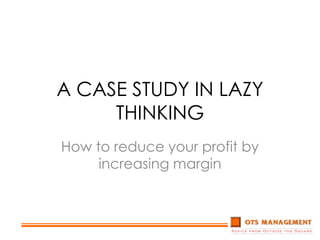
A Case Study In Lazy Thinking Selling Price And Contribution
- 1. A CASE STUDY IN LAZY THINKING How to reduce your profit by increasing margin
- 2. What you see is not always what you get The rationale seems simple – if you want more profit, you need to increase your margins. For example, if a good or service costs $100 to produce and you sell it for $150, your margin is $50 and this is that product’s contribution to overheads. So, increase the price to $200 and suddenly you contribute $100 to overheads, hence more profit.
- 3. So the figures stack up? In the previous example, assuming you sell 500 units of the product in a month and your overheads for that month are $10,000, then you have a comparison:- Lower PriceHigher Price Sell 500 units $75,000 $100,000 Cost to produce 500 $50,000 $50,000 ----------- ------------- Contribution $25,000 $50,000 Overheads $10,000 $10,000 ----------- ------------- Profit $15,000 $40,000
- 4. Is the decision made? So, for a 33.33% increase in selling price you get a 166.67% increase in profit – a no-brainer right? But wait you say, will the consumer bear a 1/3 increase in the price? Maybe not but if you do the numbers you will find that you can leverage small increases in selling price to increase the profit exponentially.
- 5. Let’s do it! Great, let’s do some customer focus groups to see what price increases they will bear, increase the price accordingly, and hey presto! We have higher profits! This is lazy thinking – let’s look at a real case study of a hotel in a tourist town.....
- 6. The situation Tourist town in the north west of Australia. For 6 months of the year, you have to book weeks in advance to get a room – for the other 6 months you can take your pick. Seeing the opportunities in tourism potential, hotel developers are increasingly expanding current facilities and building new hotels and resorts
- 7. Our hotel Our hotel is an older hotel, though renovated. Hence overheads are relatively high. It is in town rather than outside on the beaches so attracts business travellers as well as tourists who want to be in town. As part of the competition it lists on a “bucket travel” website that offers discount rooms
- 8. Our hotel’s pricing policy Through the website, the hotel rooms are $175 per night. Booking directly they are $195 per night. Why? As a customer, if you ask them why there is a difference, they tell you “we can’t compete with that website”. But hold on, THEY decide on the price they list at on the website, so what they are saying is that they can’t compete with themselves! Customers are not stupid! Internally they argue that most of their bookings are through direct bookings and they charge $195 to increase overall profits (as in our earlier example).
- 9. Is that true?? Let’s see if this is true – firstly comparing the two contributions:- WebsiteDirect One room night $175 $195 Commission at 4% $7 $0 ----------- ------------- Contribution $168 $195 So, for a difference of 11.4% in price the contribution to overheads increases by 16.07% Sounds good?
- 12. What happens rates were equal thus not all customers use the web?? 90% Website10% DirectTotal 200 rooms – per night @$175 per night $31,500 $3,500 $35,400 Commission at 4% $1,260 $0 $1,260 ---------- ---------- ---------- Contribution $30,240 $3,900 $34,140 A contribution of $34,140 is still better than a contribution of $33,600 in the previous slide, because with the equal pricing, you don’t force customers to choose the cheaper price (with cost of commissions attached) through the web. If the weighting was below 90%, the difference would be even more marked.
- 13. Numbers are a result of consumer behaviour In this case study the difference in pricing will tend to drive the rational consumer to buy at the cheaper price – the hotel’s calculations about “better margins” have no effect on the consumer and explanations like “we can’t compete with the website” only make them move faster.
- 14. What you see is not always what you get The rationale may seem simple – if you want more profit, you need to increase your margins. Unfortunately consumer behaviour is not simple and you need to look at likely contribution to overheads when you consider pricing policies. And please, do not take us for mugs and say that you can’t compete with yourself!
